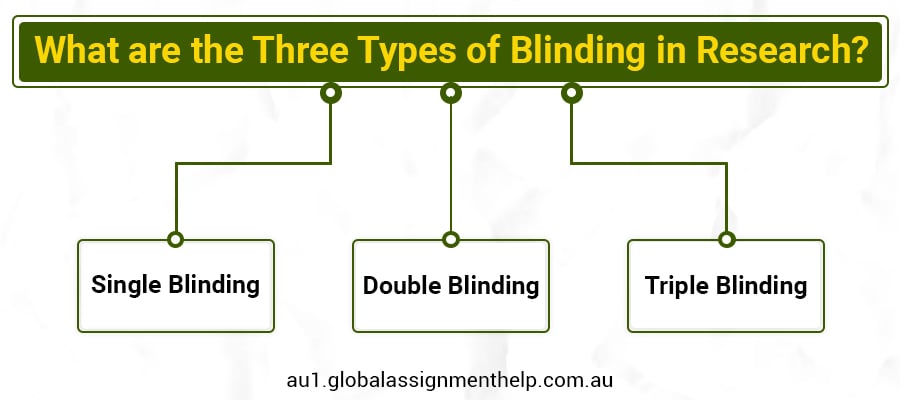 Offers
New
Order Now
Offers
New
Order Now
Are you students who have heard about blinding in research but have no idea about it? Relax, as sometimes you may come across such terms that must be new to your understanding. But there is nothing to worry about, as we, Global Assignment Help Australia, are ready to provide you with a better idea of this.
Blinding is an important technical method in research to reduce bias and ensure the reliability of study findings. Thus, a detailed document examines the idea of binding, its various forms, and its significance in the research blinding method. It goes as!
In research, Blinding is a method that keeps the researchers away from all the knowledge regarding subjects and scholars while getting a certain therapy. Thus, this ensures that the results of blinding in research are free from the researcher's expectations and helps them avoid errors.
This hiding is important for preserving the openness of the study since it keeps the subject and researcher's intentions from shifting the results. Additionally, this depends on the degree of disadvantage prevention, which is necessary. Blinding can be applied at one of three levels: single Blinding in research, double, or triple. In the long run, it improves the reliability and scientific integrity of the study results. For example, blinding means people participating in a clinical study testing a new medication have no idea if they are taking the treatment or on another medicine.
Do you want to know more about blinding in research? We have the best way to provide you with a better understanding of it. In this part, you will find two examples of it.
Example 1: Medical Study on a New Drug
In a medical study aiming to test a new drug, whether it helps in reducing headaches. The researchers administered the drug to one group and a placebo to another. Moreover, the concept of Blinding comes in, which refers to the participants not being aware of whether they are receiving the drug or the placebo. It is crucial as it prevents their expectations from influencing the results. For instance, if they were aware of taking the placebo, they might report fewer improvements due to their belief that it would be ineffective.
Example 2: Testing a New Teaching Method
A school has a study to analyze how effectively the new teaching method improves students' math skills. They implement the new method in some classes and the traditional method in others. Here, the concept of binding takes place, which ensures that the scholars are unaware of which method is superior. The teachers are also not aware of the classes involved in the study. This approach eliminates the potential influence of students' and teachers' expectations on their performance or teaching style, guaranteeing that any observed difference in results is solely attributed to the teaching method, not their preconceived notions.
Now, you must have understood the meaning of Binding in research through the example. Now, it is time to know what types of binding are used in research.
Are you still in a confusion about what is blinding in research? Then, it is just a simple method to come across the results without giving much information about the research. Besides, this study happens at different levels, each its own value and uses. They are!

1. Single Blinding: The term "single blinding in research" describes a study design in which individuals are not informed if they are getting the therapy or a control group. Because their actions and replies will not impact their knowledge of the treatment, this helps prevent participant impartiality.
2. Double Blinding: Now, you must be wondering, what is double blinding in research? It is a method that allows the participants and the researchers to offer the medication without knowing who is getting the real treatment and who is only getting a control group. Thus, this is a more severe kind of blindness and has limited use of this technique.
3. Triple Blinding: Triple Blinding involves concealing the subjects, the people giving the treatment, and the scholars doing the data analysis. Thus, this very high degree of research blinding achieves the greatest level of disadvantage prevention.
Certainly, Binding is a key method of study since it reduces disadvantages and ensures accurate and reliable results. By doing this, you can avoid situations where people report feeling better just because they think they are getting treatment. Additionally, research blinding lowers the chance that studies would, by mistake, affect the results through participant actions or expectations.
Get Research Help Today!The differences between Blinding and masking are as follows:
Blinding: Blinding in research is not telling participants, researchers, or both who is getting the treatment and who is getting a control group. By using this method, errors that can affect the outcomes are avoided. In a transparent trial, for example, neither the participants nor the researchers know the treatment assignments. Thus, this helps ensure that the effects observed are related to the treatment and not to experimental or mental variables.
Masking: Masking is a more general word that includes any method designed to conceal the identity of the treatments being given, even if it is similar to blindness. Thus, this may involve using a control group that appears the same or ensuring the treatment packaging is identical. Additionally, masking can be used not only to hide treatment allocation. However, it is also necessary to further reduce unfairness by hiding group assignments from data analysts during the analysis stage. This broad method maintains the objectivity and fairness of every study element.
To sum up, blinding is one essential method for ensuring the validity and reliability of study outcomes in research. With different degrees of research blinding, including single, double, and triple Blinding, it prevents errors. Thus, this method removes standards and attitudes that can affect the results by keeping participants, researchers, and analysts in the dark about which group they are in. However, recall that blinding is essential to excellent research.
Hence, writing a research paper can be difficult, notably when using complex methods like research blinding. Due to the difficult details, careful planning and writing are necessary to provide fair and reliable results. Moreover, there are many students who face issues in understanding how to use blinding in research in their nursing assignment. In such cases, they can seek nursing assignment help from professionals.
Thus, they can help you satisfy your academic needs; we provide excellent writing services that include topic selection, research, writing, and editing. These experts ensure your research paper meets the latest academic standards so you score high grades. Let us assist you in easily understanding every detail of your research paper.
Buy Our Academic Writing Services and Get Quick Help from Our Experts to Fetch HD Grades.
1. What is the Process of Binding in Research?
Indeed, research blinding is the practice of hiding from participants, academics, or both the course of action allocation. There are many ways of doing this, including the use of coded tags or outside managers who manage the assignment process.
2. What Type of Bias Does Blinding Prevent?
Recall that the selection, performance, and detection errors are among the disadvantages you can keep away with research blinding. It provides that participant and researcher conduct and ratings are not impacted by treatment knowledge by hiding the assignment of treatment.
3. What are the Benefits of Blinding in Research?
Blinding in research offers multiple advantages, such as improved study reliability, decreased disadvantage risk, and greater confidence in results. Thus, following the blinding process can let both participants and researchers know that the results are limited to the treatment effect.
You May Also Like to Read-
An Updated List of 100+ Subject Wise Research Paper Topics
What is the Kolb's Reflective Cycle? | It's 4 Stages of Learning
What is ATAR and How to Calculate It?
Confirmation Bias: Types, Impact and Ways to Avoid It
Don't Miss Out-Order Now!
Grab this exclusive offer and start your journey to savings today! Act quickly, as this special offer won't be around for long!

This blog explains what is a hyperbole, provides engaging examples, & explores how to use hyperbole.

Explore 150+ funny debate topics to spark laughter, creativity, and lively discussions in 2025

Cross-Sectional Study basics explained with steps, examples, and comparisons.
Limited Time Offer
Exclusive Library Membership + FREE Wallet Balance
1 Month Access !
5000 Student Samples
+10,000 Answers by Experts
Get $300 Now
Update your Number
